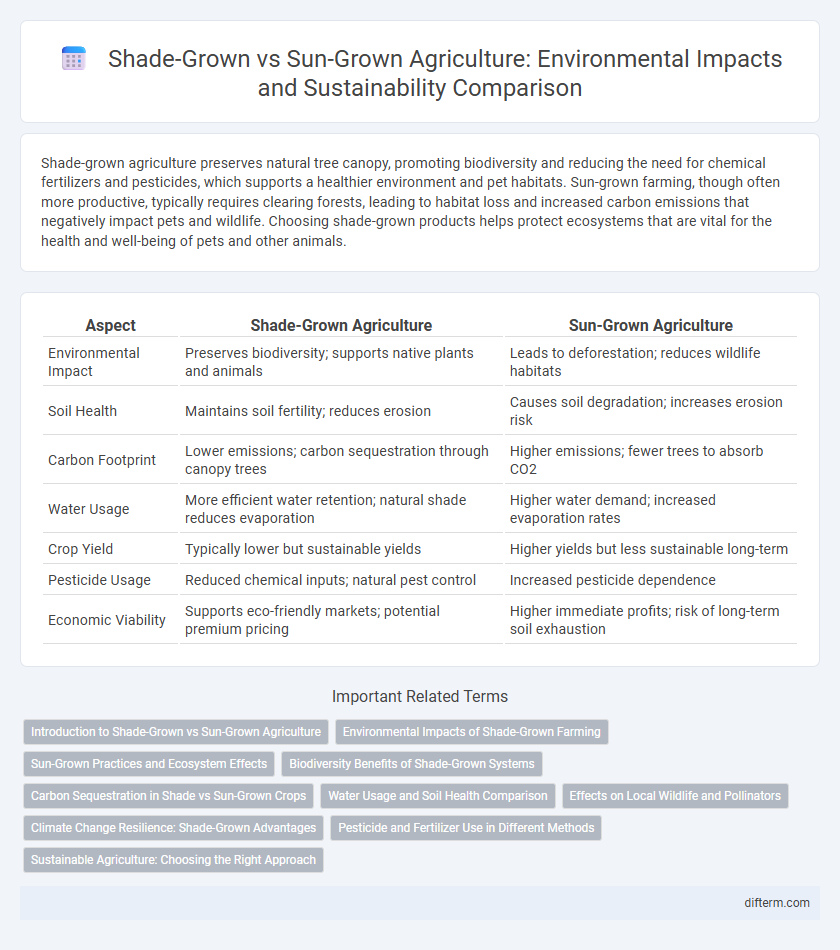Shade-grown agriculture preserves natural tree canopy, promoting biodiversity and reducing the need for chemical fertilizers and pesticides, which supports a healthier environment and pet habitats. Sun-grown farming, though often more productive, typically requires clearing forests, leading to habitat loss and increased carbon emissions that negatively impact pets and wildlife. Choosing shade-grown products helps protect ecosystems that are vital for the health and well-being of pets and other animals.
Table of Comparison
| Aspect | Shade-Grown Agriculture | Sun-Grown Agriculture |
|---|---|---|
| Environmental Impact | Preserves biodiversity; supports native plants and animals | Leads to deforestation; reduces wildlife habitats |
| Soil Health | Maintains soil fertility; reduces erosion | Causes soil degradation; increases erosion risk |
| Carbon Footprint | Lower emissions; carbon sequestration through canopy trees | Higher emissions; fewer trees to absorb CO2 |
| Water Usage | More efficient water retention; natural shade reduces evaporation | Higher water demand; increased evaporation rates |
| Crop Yield | Typically lower but sustainable yields | Higher yields but less sustainable long-term |
| Pesticide Usage | Reduced chemical inputs; natural pest control | Increased pesticide dependence |
| Economic Viability | Supports eco-friendly markets; potential premium pricing | Higher immediate profits; risk of long-term soil exhaustion |
Introduction to Shade-Grown vs Sun-Grown Agriculture
Shade-grown agriculture utilizes natural canopy cover to cultivate crops like coffee, preserving biodiversity and reducing the need for chemical inputs. Sun-grown agriculture relies on direct sunlight, often leading to higher yields but increased deforestation, soil erosion, and habitat loss. Choosing shade-grown methods supports sustainable farming practices and helps maintain ecological balance in tropical regions.
Environmental Impacts of Shade-Grown Farming
Shade-grown farming preserves biodiversity by maintaining native canopy trees that provide habitat for various species and support pollinators. It reduces soil erosion and improves water retention through natural leaf litter and root systems, enhancing soil health compared to sun-grown farming. Carbon sequestration is higher in shade-grown systems due to greater biomass, contributing to climate change mitigation.
Sun-Grown Practices and Ecosystem Effects
Sun-grown agriculture often involves clearing native vegetation to maximize crop exposure to sunlight, leading to habitat loss and decreased biodiversity. This practice can increase soil erosion and water runoff due to reduced ground cover, negatively impacting surrounding ecosystems. Sun-grown farms typically require higher chemical inputs, contributing to soil and water pollution and further stressing local wildlife populations.
Biodiversity Benefits of Shade-Grown Systems
Shade-grown agricultural systems significantly enhance biodiversity by providing diverse habitats that support various plant and animal species, including pollinators and birds. These systems maintain more complex canopy structures and microclimates, promoting ecosystem stability and resilience. Compared to sun-grown methods, shade-grown agriculture preserves native flora and fauna, contributing to greater ecological balance and conservation efforts.
Carbon Sequestration in Shade vs Sun-Grown Crops
Shade-grown crops enhance carbon sequestration by maintaining higher biomass and soil organic carbon levels compared to sun-grown crops, which often lead to soil degradation and lower carbon storage. The canopy cover in shade-grown systems moderates microclimate conditions, promoting microbial activity and organic matter accumulation crucial for long-term carbon retention. Studies reveal that shade-grown coffee plantations can sequester up to 30% more carbon than their sun-grown counterparts, contributing significantly to climate change mitigation.
Water Usage and Soil Health Comparison
Shade-grown agriculture significantly reduces water usage by maintaining cooler microclimates that slow soil evaporation, whereas sun-grown crops demand higher irrigation due to increased exposure. Shade-grown systems enhance soil health through improved organic matter retention and reduced erosion, supporting diverse microbial activity compared to the often degraded soils under sun-grown cultivation. These environmental benefits contribute to sustainable water conservation and long-term soil fertility in shade-grown farming practices.
Effects on Local Wildlife and Pollinators
Shade-grown agriculture preserves biodiversity by maintaining native tree canopy, which provides critical habitat and food sources for local wildlife and supports diverse pollinator populations like bees, butterflies, and hummingbirds. In contrast, sun-grown crops often require clearing native vegetation, leading to habitat loss, reduced species richness, and disrupted pollination networks essential for crop productivity. Research indicates that shade-grown systems enhance ecosystem services, including natural pest control and pollination efficiency, fostering more resilient agricultural landscapes.
Climate Change Resilience: Shade-Grown Advantages
Shade-grown agriculture enhances climate change resilience by maintaining higher biodiversity and promoting soil moisture retention, which helps buffer crops against extreme weather conditions. The canopy of shade trees reduces temperature fluctuations and protects crops from drought stress, contributing to more stable yields under climate variability. Studies show that shade-grown systems sequester more carbon and support ecosystem services critical for adapting to climate impacts compared to sun-grown monocultures.
Pesticide and Fertilizer Use in Different Methods
Shade-grown agriculture typically employs fewer pesticides and synthetic fertilizers due to the natural pest control and nutrient cycling provided by the surrounding canopy and biodiversity. In contrast, sun-grown systems often rely heavily on chemical pesticides and fertilizers to compensate for the lack of ecological balance and increased exposure to pests. Reducing chemical inputs in shade-grown methods supports soil health, biodiversity, and long-term sustainability in agricultural landscapes.
Sustainable Agriculture: Choosing the Right Approach
Shade-grown agriculture promotes biodiversity by preserving canopy trees, enhancing soil health, and reducing the need for chemical inputs, making it a more sustainable choice compared to sun-grown methods. Sun-grown agriculture typically yields higher short-term output but often leads to soil degradation, increased pesticide use, and loss of habitat. Emphasizing shade-grown practices supports climate resilience and long-term productivity in sustainable farming systems.
shade-grown vs sun-grown (agriculture) Infographic

 difterm.com
difterm.com